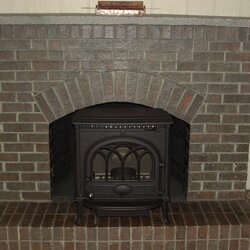Hey guys,
After lurking around here for about a year now, I have found a ton of great information that I must thank all of you for. Since I am new to the wood game I bought the Jotul F3 CB this year to supplement my oil situation. I converted a gas fireplace back to wood. When I bought the house, the brick was painted and there was a wood mantel. I replaced the wood mantel with a stone slab for clearence and scrubbed the paint off the brick with a variety of strippers. There is now 20 inches between the top of the stove and the bottom of the stone mantel.
I worry that this unsealed mantel will be heat stained? Is this something I should worry about or am I just being over anal? I am just afraid to seal the stone as this will change the color of the mantel. Thanks again for all of your advice.
After lurking around here for about a year now, I have found a ton of great information that I must thank all of you for. Since I am new to the wood game I bought the Jotul F3 CB this year to supplement my oil situation. I converted a gas fireplace back to wood. When I bought the house, the brick was painted and there was a wood mantel. I replaced the wood mantel with a stone slab for clearence and scrubbed the paint off the brick with a variety of strippers. There is now 20 inches between the top of the stove and the bottom of the stone mantel.
I worry that this unsealed mantel will be heat stained? Is this something I should worry about or am I just being over anal? I am just afraid to seal the stone as this will change the color of the mantel. Thanks again for all of your advice.



